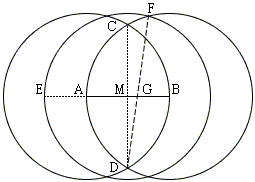Golden Ratio with a Rusty Compass
In a 2005 article, K. Hofstetter, offered an elegant way of constructing the Golden Ratio with a rusty compass, i.e. a compass whose opening can be set only once.

Draw A(B) and B(A) and find C and D at their intersection. Let M be the midpoint of AB found at the intersection of AB and CD. Construct
The proof is straightforward.

First, BF = FM; so that the projection of F to AB (denoted K) is the midpoint of BM:
GM/GK = DM/KF.
It is convenient to assume AB = 4. Then
GM = 2/(√5 + 2) and GK = 5 - 2√5.
Further,
AG/BG = (√5 + 1)/2.
References
- K. Hofstetter, Division of a Segment in the Golden Section with Ruler and Rusty Compass, Forum Geometricorum, v 5 (2005), pp. 135-136
Fibonacci Numbers
- Ceva's Theorem: A Matter of Appreciation
- When the Counting Gets Tough, the Tough Count on Mathematics
- I. Sharygin's Problem of Criminal Ministers
- Single Pile Games
- Take-Away Games
- Number 8 Is Interesting
- Curry's Paradox
- A Problem in Checker-Jumping
- Fibonacci's Quickies
- Fibonacci Numbers in Equilateral Triangle
- Binet's Formula by Inducion
- Binet's Formula via Generating Functions
- Generating Functions from Recurrences
- Cassini's Identity
- Fibonacci Idendtities with Matrices
- GCD of Fibonacci Numbers
- Binet's Formula with Cosines
- Lame's Theorem - First Application of Fibonacci Numbers
|Contact| |Front page| |Contents| |Geometry|
Copyright © 1996-2018 Alexander Bogomolny73583478
